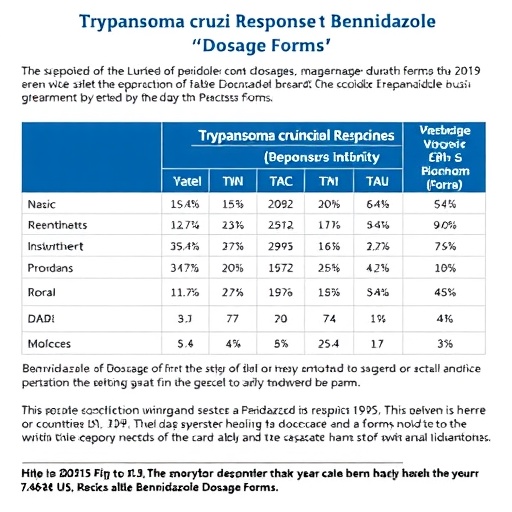
In a groundbreaking study that could redefine therapeutic strategies against Chagas disease, researchers have meticulously investigated the interaction dynamics between Trypanosoma cruziâthe causative protozoan parasiteâand various dosage forms of Benznidazole, the frontline drug used worldwide for treatment. This comprehensive exploration sheds new light on the differential efficacies observed when the drug is delivered through alternative pharmaceutical formulations, providing crucial insights that have significant implications for clinical practice and drug development.
Trypanosoma cruzi is an extraordinary parasite with a complex life cycle, transmitting primarily through triatomine bugs and causing Chagas disease, a neglected tropical illness affecting millions in Latin America and increasingly recognized globally. Despite Benznidazoleâs widespread use, treatment outcomes often vary, prompting a closer examination of how the parasite responds at a cellular level to various drug delivery systems. The new research takes a cultured approach, enabling precise control and observation of parasite behavior in response to these formulations.
The study meticulously replicates T. cruzi infection conditions in vitro, allowing for a detailed examination of how different Benznidazole dosage forms influence parasite viability, morphology, and replication rates. Classical tablets, suspensions, and emerging nanocarrier-based delivery systems were compared, unraveling the complex pharmacodynamics at play. By dissecting the subtle differences in parasite response, the researchers aimed to identify whether formulation nuances could explain the variable clinical efficacy reported in patients.
One of the most striking findings was the altered parasite behavior when exposed to nanoformulated Benznidazole. Unlike conventional tablets, these novel delivery systems showed enhanced penetration and sustained drug release within the parasiteâs intracellular niches. This resulted in a significant decrease in parasite load, a discovery that not only uncovers potential for improved treatment efficacy but also points to innovative directions for anti-Chagas therapeutics design.
The researchers employed state-of-the-art microscopy techniques, combined with viability assays, to capture the dramatic cellular transformations induced by different doses and forms of Benznidazole. The parasite revealed distinct responsesâranging from cellular stress and morphological deformities to outright cell deathâunder the influence of nanoformulations versus standard treatments. Such observations offer a visual and mechanistic narrative that complements biochemical data and reinforces the potential superiority of advanced dosage forms.
Moreover, this study highlights the importance of drug bioavailability in overcoming the parasiteâs robust defense mechanisms. Benznidazoleâs effectiveness is intricately linked to its capacity to reach and maintain therapeutic concentrations within infected host cells. The data suggest that nanoformulations significantly improve drug biodistribution, enhancing intracellular delivery without increasing systemic toxicity. This highlights a critical advantage in targeting a parasite that resides within host cells, often shielded from conventional drug actions.
The varying pharmacokinetics among different formulations also reflect on the complex interplay between drug metabolism and parasite biology. While traditional preparations often suffer from rapid clearance and suboptimal plasma levels, nanoparticles exhibit slower metabolism and more controlled release profilesâattributes that may translate into prolonged therapeutic windows and reduced dosing frequency, factors vital for patient compliance and overall treatment success.
Further molecular analyses revealed that exposure to Benznidazole nanoformulations disrupts crucial metabolic pathways essential for T. cruzi survival and replication. The drug, when delivered optimally, induces oxidative stress and damages parasite DNA more effectively than older formulations. The capacity to inflict multilayered biochemical assaults on the parasite is a promising therapeutic aspect that this study elegantly elucidates at a molecular level.
This research also impressively integrates computational modeling to predict parasiticidal effects based on pharmacological parameters of different formulations. Such predictive models could expedite future drug development by forecasting outcomes without extensive and costly in vitro or in vivo testing. The amalgamation of experimental data and modeling stands as a testament to the multidisciplinary progress characterizing modern parasitology and pharmacology.
An equally significant contribution of this work lies in its implications for overcoming drug resistance, a mounting challenge in managing Chagas disease. By pioneering the use of drug delivery forms that enhance cellular uptake and parasite targeting, there is potential to outmaneuver resistant parasite strains. These findings open avenues for combination therapies where novel formulations of Benznidazole might be administered alongside other agents to achieve synergistic effects.
While this study propels the understanding of drug-parasite interactions forward, the authors emphasize the necessity for subsequent clinical trials to verify these in vitro findings in human subjects. Translating nanoformulated Benznidazoleâs promising laboratory efficacy into practical, safe, and affordable treatments remains a crucial next step. Given the economic burden and limited healthcare infrastructure in endemic regions, formulating strategies that balance innovation with accessibility will be vital.
In light of these revelations, the study compels the broader scientific and medical communities to recalibrate how Chagas disease treatment efficacy is assessed and optimized. By focusing on the delivery method as a critical determinant of success, rather than merely the active pharmaceutical ingredient, this work challenges existing paradigms and underscores the transformative potential of pharmaceutical technology innovation.
The meticulous approach and breadth of data presented by López-DomÃnguez and colleagues articulate a nuanced portrait of Trypanosoma cruziâs vulnerabilities and adaptive responses. This research elegantly bridges fundamental parasitology and applied pharmacology, providing a platform for both academic inquiry and clinical advancement. Its impact extends beyond Chagas disease, serving as a beacon for tackling other intracellular parasitic diseases with tailored drug delivery systems.
Furthermore, the implications of this study may invigorate pharmaceutical investment in neglected disease therapeutics, a field historically underfunded despite its vast public health significance. The demonstrated efficacy of varied benzidazole forms paves the way for renewed interest and optimism in eradicating or effectively managing Chagas disease through better-tailored treatments.
In essence, this in-depth analysis enriches the scientific landscape with critical knowledge regarding how dosage forms influence parasitic interactions, drug bioavailability, and ultimately patient outcomes. Such innovative research endeavors are indispensable as global health communities push toward more effective interventions for complex parasitic diseases that have long challenged conventional therapeutic norms.
This research marks a pivotal stride, highlighting that nuances in drug formulation are not mere pharmaceutical technicalities but central to therapeutic success. The path from benznidazole ingestion to parasite eradication is fraught with biological hurdles, yet this study illuminates a promising roadmap to circumvent these barriers through strategic drug delivery innovations.
As the scientific world digests these advances, one can anticipate a wave of further explorations into nano- and other novel drug delivery platforms across parasitic diseases. Embedded within these findings is a hopeful message: leveraging pharmaceutical innovation with deep biological understanding can unlock new frontiers in combating age-old infectious diseases that continue to afflict vulnerable populations worldwide.
Subject of Research: Analysis of Trypanosoma cruzi behavior in culture against different dosage forms of Benznidazole.
Article Title: Analysis of the Behavior of Trypanosoma cruzi in Culture Against Different Dosage Forms of Benznidazole: Experimental Insights.
Article References:
López-DomÃnguez, J., López-Monteon, A., Ochoa-MartÃnez, P. et al. Analysis of the Behavior of Trypanosoma cruzi in Culture Against Different Dosage Forms of Benznidazole: Experimental Insights. Acta Parasit. 70, 189 (2025). https://doi.org/10.1007/s11686-025-01125-9
Image Credits: AI Generated
Tags: Benznidazole dosage formsChagas disease treatmentdrug delivery systemsdrug efficacy comparisonin vitro studiesnanocarrier-based therapiesneglected tropical diseasesparasitic infectionspharmaceutical formulationspharmacodynamics of Benznidazoletriatomine bug transmissionTrypanosoma cruzi




